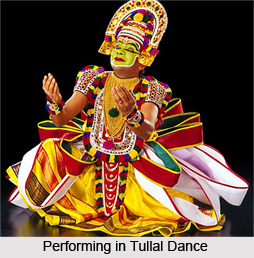 The Tullal dance form is a solo exposition, and is mainly of three types. The origin of the dance form can be attributed to a famous poet of Kerala named Kunchan Nambiar. Even though the dance form is based on the principle of Natya Shastra, but the technique is not rigid. The popularity of the tullal dance form depends on the fact that it is well written in easy Malayalam language, frank and outspoken humour and wit, the simplicity of presentation has made this dance form a popular art in everyday life.
The Tullal dance form is a solo exposition, and is mainly of three types. The origin of the dance form can be attributed to a famous poet of Kerala named Kunchan Nambiar. Even though the dance form is based on the principle of Natya Shastra, but the technique is not rigid. The popularity of the tullal dance form depends on the fact that it is well written in easy Malayalam language, frank and outspoken humour and wit, the simplicity of presentation has made this dance form a popular art in everyday life.
The instruments that are used in thullal are cymbals and maddalam. The cymbal player, whose main job is to tune the rhythm, as helps the director of dancing in singing. In a live performance the cymbal player the person playing the cymbal first sings the invocation song while the dancer faces the orchestra and does obeisance. After that with his back to the audience he performs a sleek flourish of step and body movements. Afterwards we turn to the audiences and proper dance performance begins. He sings the lines and when the musician plays the chords we enacts the meaning of the lines through mimes and gestures, facial expression and body postures. The roles of the actor and raconteur are perpetually interchanged with great aesthetic efforts. At one moment he is the narrator and in the next he completely identifies himself with the narration.
In thullal, the prime focus is given to dance itself. From the beginning to the end much of the importance is given to the dance form itself. And to overcome the monotony sometimes the dancers even execute the dance steps through vigorous steps and rhythmic movements of the body. Thullal can be divided into Ottan, Seethankan and Parayan based on the difference in dance, costume and also the rhyme and meter of the Thullal songs. The costume is impressive and peculiar. The long tape of red and white colour is hooked around the waist string to form the knee length skirt. The chest plate is decorated with many types of glass, coloured beades, ornaments and tinsel. Wooden jewellery is worn gaudily on wrist and shoulders. Above the calf muscle tinkling bells are tied and the face is painted green and lips reddened and eyes coloured with black paint. The head dress is decorated colourfully and dancers perform along with the rhyme of Ottan Thullal.



















